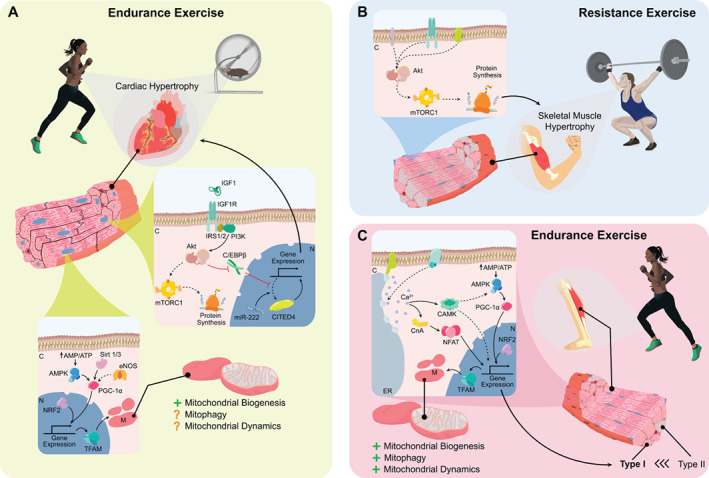Figure 1.

Physiological adaptation in cardiac and skeletal muscle. (A) The adaptive effects of endurance exercise on cardiac muscle are governed by special signal transduction pathways and mitochondrial quality control. Upper panel: exercise stimulates binding of insulin‐like growth factor 1 (IGF1) to a specific transmembrane tyrosine kinase membrane receptor (IGF1R), causing a conformational change that recruits and phosphorylates insulin receptor substrates 1 and 2 (IRS1/2). In turn, the activation of IRS1/2 phosphorylates phosphoinositide 3 kinase (PI3K) and further downstream activation of protein kinase B (Akt). The diverse effects of Akt activation include for example activation of endothelial nitric oxide synthase (eNOS), activation and/or inhibition of sirtuins, inhibition of glycogen synthase kinase 3β as well as inhibition of forkhead box protein O3 (FOXO3). Most importantly, however, activation of Akt subsequently (i) promotes protein synthesis through activation of mammalian target of rapamycin complex 1 (mTORC1), its downstream activation of ribosomal protein S6 kinase 1 (S6K1) and inhibition of eIF4E‐binding protein 1 (4EBP1) and (ii) by inhibiting the transcriptional repressor CCAAT/enhancer binding protein‐β (C/EBPβ) to activate a specific physiological growth programme downstream of the transcription factor CBP/p300‐interacting trans activator 4 (CITED4). Lower panel: exercise also enhances mitochondrial performance through enhanced mitochondrial biogenesis, and potentially also through increased mitochondrial clearance (mitophagy) and mitochondrial morphological changes (mitochondrial dynamics). Exercise stimulates mitochondrial biogenesis through activation of AMP‐activated protein kinase (AMPK) and upregulation of sirtuin 1/3 (SIRT1/3) and eNOS. These factors in turn promote the activity of the transcription factor peroxisome‐proliferator‐activated‐receptor gamma coactivator 1‐alpha (PGC‐1α) and its downstream factors nuclear respiratory factor 2 (NRF2) and mitochondrial transcription factor A (tFAM). NRF2 and tFAM are both essential for the generation of new mitochondrial proteins. (B) Resistance exercise induces skeletal muscle hypertrophy mediated through Akt, which activates mTORC1 leading to the synthesis of new proteins and muscle growth. (C) In skeletal muscle, endurance exercise causes an increase in mitochondrial biogenesis, mitophagy and mitochondrial dynamics. Mitochondrial biogenesis is regulated by activation of AMPK, PGC‐1α and downstream NRF2 as well as tFAM. An additional effect of exercise in skeletal muscle fibres includes a shift toward a more oxidative composition through calcineurin (CnA) mediated activation of nuclear factor of activated T‐cells (NFAT) and Ca2+/calmodulin‐dependent protein kinase (CaMK), or through modulation of AMPK and PGC‐1α. Full lines indicate direct effects, dashed lines indicate indirect effects. AMP, adenine nucleotide monophosphate; ATP, adenine nucleotide triphosphate; C, cytoplasm; Ca2+, calcium; ER, endoplasmic reticulum; M, mitochondria; miR‐222, microRNA; N, nucleus.
